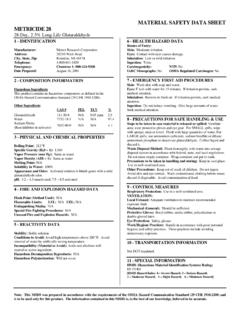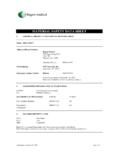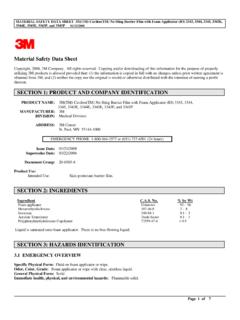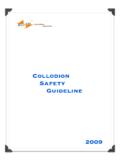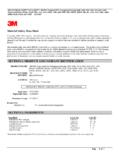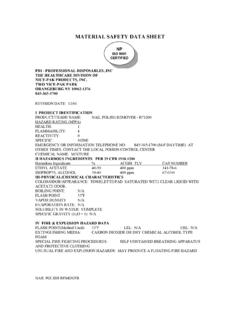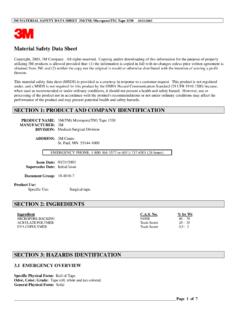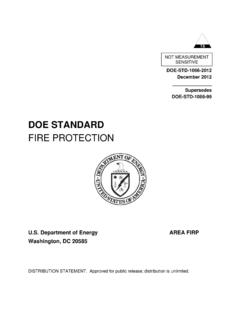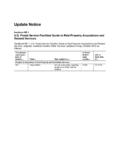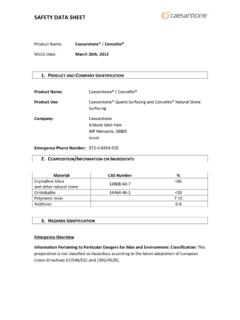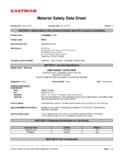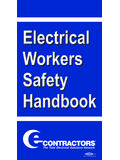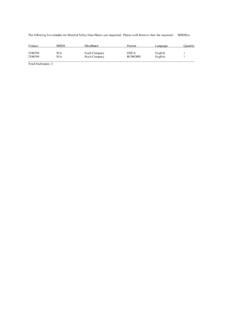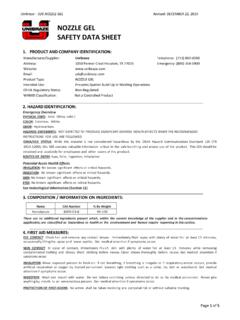Transcription of Material Safety Data Sheet Detachol Adhesive …
1 Material Safety data Sheet Detachol Adhesive Remover Page 1 of 5 1. PRODUCT & COMPANY IDENTIFICATION Product Identification: Detachol Adhesive Remover Ferndale Laboratories, Inc. 780 West Eight Mile Road Ferndale, Michigan 48220-2498 Manufacturer: Telephone Number: 1-248-548-0900 Fax Number: 1-248-548-8427 2. INGREDIENTS/IDENTITY INFORMATION Proprietary: No Ingredient: Odorless Mineral Spirits [Naphtha , (petroleum), hydrotreated, heavy] Ingredient Sequence Number: 01 Percent: CAS Number: 64742-48-9 Proprietary: No Ingredient: D & C Red #17 Ingredient Sequence Number: 02 Percent: < Proprietary: Yes Ingredient: Many Flowers Fragrance Ingredient Sequence Number: 03 Percent: < 3.
2 HAZARD IDENTIFICATION Emergency Overview: This Material is HAZARDOUS by OSHA Hazard Communication definition. Signal Words: DANGER! COMBUSTIBLE Health Flammability Reactivity Hazardous Materials Identification (HMIS) 1 2 0 National Fire Protection Association (NFPA) 1 2 0 Potential Health Effects: Routes of Exposure: Inhalation, Skin, Ingestion, Eye Variability Among Individuals: Health studies have shown that many petroleum hydrocarbons and synthetic lubricants pose potential human health risks which may vary from person to person. As a precaution, exposure to liquids, vapors, mists or fumes should be minimized. Effects of Overexposure: High vapor concentrations (greater than approximately 1000 ppm) are irritating to the eyes and respiratory tract, and may cause headaches, dizziness, anesthesia, drowsiness, unconsciousness, and other central nervous system effects, including death.
3 Conditions Aggravated by Exposure Skin contact may aggravate an existing dermatitis. Material Safety data Sheet Detachol Adhesive Remover Page 2 of 5 4. FIRST AID MEASURES Take precautions to ensure your own health and Safety before attempting rescue and providing first aid. Inhalation: If overcome by vapor, remove from exposure and call a physician immediately. If breathing is irregular or has stopped, start resuscitation, administer oxygen if available. Eye: Thoroughly flush the eyes with large amounts of clean low-pressure water for at least 15 minutes, occasionally lifting the upper and lower eyelids. If irritation persists, call a physician. Skin: In case of skin contact, remove any contaminated clothing and wash skin with soap and water. Launder or dry-clean clothing before reuse. If product is injected into or under the skin, or into any part of the body, regardless of the appearance of the wound or its size, the individual should be evaluated by a physician as a surgical emergency.
4 Even though initial symptoms from high pressure injection may be minimal or absent, early surgical treatment within the first few hours may significantly reduce the ultimate extent of injury. Ingestion: If ingested, DO NOT induce vomiting; call a physician immediately. 5. FIRE FIGHTING Flash Point: (odorless mineral spirits) 49 C (120 F) ASTM D 56, Tag Closed Cup Autoignition Temperature: (odorless mineral spirits) Approximately 349 C (660 F) ASTM D2155 Flammable or Explosive Limits (Approximate percent by volume in air) Lower Explosive Limit: (estimated value - odorless mineral spirits) Upper Explosive Limit: (estimated value - odorless mineral spirits) Extinguishing Media and Fire Fighting Procedures: Foam, water spray (fog), dry chemical carbon dioxide and vaporizing liquid type fire extinguishing agents may all be suitable for extinguishing fires involving this type of product, depending on size or potential size of fire and circumstances related to the situation.
5 Plan fire protection and response strategy through consultation with local fire protection authorities or appropriate specialists. The following procedures for this type of product are based on the recommendations in the National Fire Protection Association s Fire Protection Guide on Hazardous Materials , Tenth Edition (1991). Use dry chemical, foam or carbon dioxide to extinguish the fire. Water may be ineffective , but water should be used to keep fire-exposed containers cool. If a leak or spill has ignited, use water spray to disperse the vapors and to protect persons attempting to stop a leak. Water spray may be used to flush spills away from exposures. Minimize breathing of gases, vapor, fumes or decomposition products. Use supplied-air breathing equipment for enclosed or confined spaces or as otherwise needed. NOTE: The inclusion of the phrase Water may be ineffective is to indicate that although water can be used to cool and protect exposed Material , water may not extinguish the fire unless used under favorable conditions by experienced fire fighters trained in fighting all types of flammable liquid fires.
6 Decomposition: Fumes, smoke, carbon monoxide, sulfur oxides, aldehydes and other decomposition products, in the case of incomplete combustion. 6. ACCIDENTAL RELEASE MEASURES Clean Water Act / Oil Pollution Act: This product may be classified as an oil under Section 311 of the Clean Water Act, and under the Oil Pollution Act. Discharge or spills into or leading to surface waters that cause a sheen must be reported to the National Response Center (1-800-424-8802). Material Safety data Sheet Detachol Adhesive Remover Page 3 of 5 Steps To Be Taken In Case Material Is Released Or Spilled: Shut off and eliminate all ignition sources. Keep people away. Recover free product. Add sand, earth or other suitable absorbent to spill area. Minimize breathing vapors. Minimize skin contact. Ventilate confined spaces. Open all windows and doors. Keep product out of sewers and watercourses by diking or impounding.
7 Advise authorities if product has entered or may enter sewers, watercourses, or extensive land areas. Assure conformity with applicable government regulations. Continue to observe precautions for volatile, combustible vapors from absorbed materials. 7. HANDLING AND STORAGE Handling Precautions: This liquid is volatile and gives off invisible vapors. Either the liquid or vapor may settle in low areas or travel some distance along the ground or surface to ignition sources where they may ignite or explode. Keep product away from ignition sources, such as heat, sparks, pilot lights, static electricity, and open flames. Empty Container Warning: Empty containers retain residue (liquid and/or vapor) and can be dangerous. Do not pressurize, cut weld, braze, solder, drill grind or expose such containers to heat, flame, sparks, static electricity or other sources of ignition; they may explode and cause injury or death.
8 Do not attempt to refill or clean containers since residue is difficult to remove. All containers should be disposed of in an environmentally safe manner and in accordance with government regulations. 8. EXPOSURE CONTROLS/PERSONAL PROTECTION Exposure limit for total product (odorless mineral spirits): 177 ppm based on total hydrocarbon for an 8-hour workday. Ventilation: Use only with ventilation sufficient to prevent exceeding recommended exposure limit or buildup of explosive concentration of vapor in air. No smoking, or use of flame or other ignition sources. Respiratory Protection: Use supplied-air respiratory protection in confined or enclosed spaces, if needed. Protective Gloves: Use chemical-resistant glove, if needed, to avoid prolonged or repeated skin contact. Eye Protection: Use splash goggles or face shield when eye contact may occur.
9 Other Protective Equipment: Use chemical-resistant apron or other impervious clothing, if needed, to avoid contaminating regular clothing, which could result in prolonged or repeated skin contact. Work Practices/Engineering Controls: To prevent fire or explosion risk from static accumulation and discharge, effectively bond and/or ground product transfer system in accordance with National Fire Protection publications. Keep containers closed when not in use. Do not store near heat, sparks, flame or strong oxidants. To prevent fire and explosion risk from static accumulation and discharge, effectively bond and/or ground product transfer system in accordance with the National Fire Protections standard for petroleum products. In order to prevent fire or explosion hazards, use appropriate equipment. Information on electrical equipment appropriate for use with this product may be found in the latest edition of the National Electrical Code (NFPA-70), This document is available from the National Fire Protection Association, Batterymarch Park, Quincy, Massachusetts 02269.
10 Personal Hygiene: Minimize breathing vapor or mist. Avoid prolonged or repeated contact with skin. Remove contaminated clothing; launder or dry clean before re-use. Remove contaminated shoes and thoroughly clean and dry before re-use. Cleanse skin thoroughly after contact, before breaks and meals, and at end of work period. Product is readily removed from skin by waterless hand cleaners followed by washing thoroughly with soap and water. Material Safety data Sheet Detachol Adhesive Remover Page 4 of 5 9. PHYSICAL AND CHEMICAL PROPERTIES Appearance: clear orange liquid Boiling Range: (odorless mineral spirits) 178-189 C (354-372 F) Vapor Pressure (mm Hg @ 70 C): (odorless mineral spirits) mm Hg @ 20 C (68 F) ASTM D 2879 Vapor Density (Air = 1) (odorless mineral spirits) Percent Volatiles by Volume: (odorless mineral spirits) Approx.
